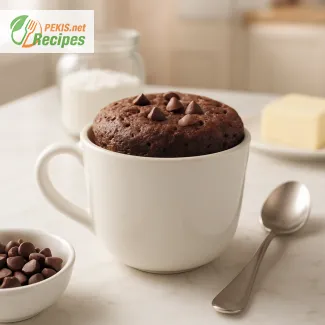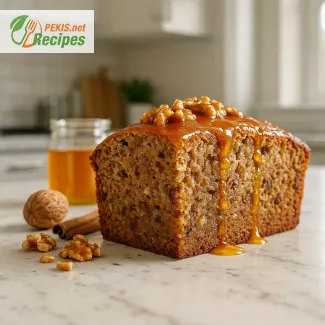
Chocolate Cake with Ganache Topping is a quintessential dessert that represents indulgence at its finest. This rich, luscious cake is defined by its moist, tender crumb, complemented by a smooth, decadent ganache that blankets the surface. Often crafted with high-quality dark chocolate, this cake offers a depth of flavor that captivates chocolate lovers worldwide. Its versatility makes it ideal for both everyday indulgence and grand celebrations, giving it a timeless appeal that never fades.
Purpose and Popularity
The primary purpose of a Chocolate Cake with Ganache Topping is to offer a luxurious chocolate experience that balances the richness of the cake with the velvety smoothness of ganache. This cake is a showstopper for birthdays, anniversaries, weddings, and other events, and is equally enjoyed as a comfort dessert for quiet moments at home. Its popularity is due to the harmonious pairing of textures and flavors: the slightly bitter, intense chocolate ganache with the sweet, melt-in-your-mouth cake. Whether layered or served as a single-tier delight, it presents a sophisticated treat that suits every type of gathering.
Types and Varieties
Several variations of Chocolate Cake with Ganache Topping exist, each offering a unique twist on the classic. Here’s a look at some popular styles:
- Classic Dark Chocolate Ganache Cake: This type is the purest form of chocolate indulgence. Made with high-quality dark chocolate and heavy cream, the ganache creates a thick, shiny layer that sets slightly while retaining a creamy center. Ideal for those who enjoy a rich, intense flavor, this cake is sometimes enhanced with espresso to bring out the chocolate’s full complexity.
- Milk Chocolate Ganache Cake: For those preferring a lighter, sweeter option, milk chocolate ganache is often used. It results in a creamier, smoother topping with less bitterness. This variety is popular with younger audiences and those who enjoy a sweeter dessert experience. It can be adorned with chocolate shavings, berries, or edible flowers to add contrast and flavor balance.
- White Chocolate Ganache Cake: A unique twist that uses white chocolate for a milder, buttery flavor, creating a soft ivory topping. This variation often incorporates vanilla or citrus zest to counter the sweetness, giving it a delicate, refined quality. White chocolate ganache cakes are particularly eye-catching at weddings and celebrations where a lighter aesthetic is desired.
- Raspberry or Strawberry Ganache Cake: Adding a fruit element to the ganache, such as raspberry or strawberry puree, gives this cake a beautifully balanced flavor profile. The tartness of the fruit cuts through the richness of the chocolate, creating a refreshing twist. This variation is perfect for spring and summer events and appeals to those who appreciate a hint of fruitiness with their chocolate.
- Vegan Chocolate Ganache Cake: For plant-based diets, vegan versions use coconut milk or almond milk in place of dairy and sometimes a mix of avocado and coconut oil to replicate the richness. This cake maintains the same silky, smooth topping while remaining entirely dairy-free. It’s a popular option for those with dietary restrictions, offering a satisfying experience without compromising on flavor or texture.
- Flourless Chocolate Ganache Cake: Also known as a gluten-free chocolate cake, this variation is extremely dense and rich. With no flour, the cake takes on a fudgy consistency that pairs well with a thin layer of ganache. This version is naturally gluten-free and ideal for those who prefer a dense, chocolatey experience over a traditional crumb.
Key Ingredients and Their Role
Creating the perfect Chocolate Cake with Ganache Topping requires a selection of essential ingredients that contribute to its unforgettable taste and texture. Here’s a look at the primary components:
- Chocolate: The quality of chocolate used in both the cake and ganache is critical. Opting for high cocoa content—at least 60-70%—for dark chocolate results in a robust, intense flavor. Milk chocolate offers a sweeter, softer flavor profile, while white chocolate contributes a creamy, buttery undertone.
- Heavy Cream: Essential for ganache, heavy cream adds a luxurious smoothness that helps the chocolate achieve its silky consistency. It also enables the ganache to thicken and form a shiny, beautiful finish on the cake.
- Butter: Used in the cake batter and sometimes in ganache, butter enhances the cake’s moistness and creates a rich, tender crumb. It contributes to the depth of flavor, balancing the bitterness of dark chocolate with a creamy, melt-in-your-mouth sensation.
- Eggs: Acting as a binding agent, eggs give the cake structure and stability. They also add to the cake’s richness and help it rise to the perfect consistency.
- Sugar: Adds sweetness to balance the bitterness of chocolate and helps create a moist, tender texture in the cake. Some variations use brown sugar for a deeper caramel note.
- Vanilla Extract: Though subtle, vanilla enhances the chocolate flavor by adding warmth and complexity to the overall taste.
Presentation and Garnishing
Chocolate Cake with Ganache Topping is not only a treat for the taste buds but also a visual masterpiece. The ganache’s mirror-like finish creates a perfect canvas for adding elegant garnishes. Here are some popular options:
- Chocolate Shavings or Curls: These add a sophisticated touch and bring out the layered flavors of chocolate in each bite.
- Edible Gold Leaf or Silver Dust: For a truly decadent appearance, adding gold or silver touches elevates the presentation, making it ideal for weddings or luxurious gatherings.
- Fresh Berries: Strawberries, raspberries, or blackberries provide a tart contrast to the rich chocolate and add a splash of color, enhancing both flavor and visual appeal.
- Nuts: Finely chopped hazelnuts, almonds, or pistachios offer a delightful crunch and complement the smooth texture of the ganache.
Why It’s Irresistible
The appeal of Chocolate Cake with Ganache Topping lies in its ability to satisfy chocolate cravings while offering a multi-dimensional dessert experience. The contrast between the soft, airy cake and the dense, creamy ganache creates a satisfying mouthfeel. Moreover, the ganache’s bittersweet undertone perfectly balances the cake’s sweetness, resulting in a harmonious bite.
This cake is beloved across cultures for its versatility and universal appeal. It is a testament to chocolate’s ability to bring people together, offering a moment of pure, unadulterated indulgence. Each bite promises an explosion of chocolate flavor, making it the ideal choice for chocolate aficionados and those seeking a memorable, luxurious dessert experience.
- Preheat and Prepare:
- Preheat your oven to 180°C (350°F). Grease a 20 cm (8-inch) round cake tin and line it with parchment paper for easy removal.
- Melt Chocolate and Butter:
- In a heatproof bowl over a pot of simmering water (double boiler), melt 200 g (7 oz) of dark chocolate and 200 g (7 oz) of butter together. Stir until smooth and set aside to cool slightly.
- Combine Dry Ingredients:
- In a separate bowl, sift together the flour (100 g or ¾ cup), cocoa powder (50 g or ¼ cup), baking powder (1 tsp or 5 ml), and salt (¼ tsp or 1.25 ml).
- Mix Eggs and Sugar:
- In a large mixing bowl, beat the eggs and sugar together until pale and fluffy, about 3-4 minutes. The mixture should double in volume.
- Combine Wet and Dry Ingredients:
- Slowly fold the melted chocolate and butter mixture into the egg and sugar mixture until fully combined. Gently fold in the dry ingredients, mixing until just combined.
- Bake the Cake:
- Pour the batter into the prepared cake tin and bake for 40-45 minutes, or until a skewer inserted in the center comes out with a few moist crumbs (not wet batter).
- Cool the Cake:
- Let the cake cool in the tin for 10 minutes, then remove it from the tin and let it cool completely on a wire rack.
- Prepare the Ganache:
- While the cake cools, make the ganache. Heat the heavy cream (200 ml or ⅔ cup) in a small saucepan over medium heat until it just begins to simmer. Pour it over the chopped chocolate (200 g or 7 oz) in a heatproof bowl. Allow it to sit for 1-2 minutes, then stir until smooth. For extra shine, add the optional 30 g (2 tbsp) of butter and stir until melted.
- Assemble:
- Once the cake has completely cooled, pour the ganache over the top, allowing it to gently drip down the sides for a polished finish. Let the ganache set for about 15-20 minutes before serving.
This Chocolate Cake with Ganache Topping is a deliciously indulgent dessert that combines the rich flavors of chocolate with a smooth ganache finish, making it the perfect treat for any occasion.
Nutritional and Health Impact of Ingredients in Chocolate Cake with Ganache Topping
This Chocolate Cake with Ganache Topping is more than a dessert; it combines ingredients that offer both indulgent flavors and nutritional properties. Here’s an analysis of how each key ingredient affects the body, the health implications of the nutrients, and the potential benefits and considerations when enjoying this treat.
1. Dark Chocolate
Nutrient Profile and Impact: Dark chocolate, particularly varieties with higher cocoa content (60-70% or more), is rich in antioxidants like flavonoids, which support cardiovascular health. Antioxidants help reduce oxidative stress, potentially lowering the risk of chronic diseases. Additionally, dark chocolate provides minerals such as iron, magnesium, copper, and manganese.
- Iron: Essential for red blood cell formation and oxygen transport. Iron helps combat fatigue and supports cognitive function.
- Magnesium: Involved in muscle and nerve function, blood sugar control, and blood pressure regulation. Magnesium can also help reduce stress and promote relaxation.
- Copper and Manganese: Both are essential for energy production, immune function, and antioxidant defense.
Considerations: While dark chocolate offers health benefits, it is calorie-dense and should be enjoyed in moderation. The flavonoids in dark chocolate have been shown to support heart health by improving blood flow, lowering blood pressure, and reducing the risk of blood clots.
2. Unsalted Butter
Nutrient Profile and Impact: Butter adds richness and moisture to the cake, contributing to its smooth texture. As a source of saturated fats, butter provides energy but should be consumed in moderation, as high intake of saturated fats can impact cholesterol levels.
- Vitamin A: Butter is a significant source of Vitamin A, crucial for immune health, vision, and skin health.
- Butyrate: A short-chain fatty acid produced from butter in the gut, which has been linked to anti-inflammatory properties and improved gut health.
Considerations: While butter has health benefits, excessive consumption of saturated fats may contribute to elevated cholesterol levels. Opting for unsalted butter helps manage sodium intake, which is important for heart health.
3. Granulated Sugar
Nutrient Profile and Impact: Sugar is a quick source of glucose, providing immediate energy for the body and brain. However, it’s essential to consume it within recommended limits due to its potential effects on blood sugar levels and weight management.
Considerations: Excessive sugar intake can lead to spikes in blood glucose levels, impacting insulin sensitivity and potentially leading to energy crashes or, over time, to chronic conditions like Type 2 diabetes. Enjoying sugar in moderation, especially in a recipe balanced by other nutrients, is key.
4. Eggs
Nutrient Profile and Impact: Eggs are a nutrient-dense addition, providing high-quality protein along with essential vitamins and minerals.
- Vitamin B12: Important for red blood cell formation, nerve function, and DNA synthesis.
- Choline: Supports brain health, liver function, and metabolism.
- Protein: Essential for tissue repair, muscle maintenance, and overall cellular function.
Considerations: Eggs are a complete protein source, meaning they contain all essential amino acids. The protein content contributes to satiety, making this dessert more filling and helping prevent overconsumption. The presence of cholesterol in eggs has a negligible impact on blood cholesterol levels for most people.
5. All-Purpose Flour
Nutrient Profile and Impact: Flour provides the carbohydrates that give the cake its structure and contribute to its softness. Carbohydrates are the body’s primary energy source and are especially important for brain function.
- Folic Acid (if enriched): Plays a role in DNA synthesis and repair and is essential during periods of rapid growth, such as pregnancy.
Considerations: White flour is low in fiber, and consumption in large amounts could lead to blood sugar spikes. Choosing whole grain alternatives or enjoying white flour in moderation helps maintain energy levels and digestive health.
6. Cocoa Powder
Nutrient Profile and Impact: Cocoa powder is not only flavor-rich but also packed with polyphenols and flavonoids, which are powerful antioxidants.
- Flavonoids: These antioxidants may improve blood flow, reduce inflammation, and support heart health.
- Potassium: Helps maintain proper heart function and muscle contraction, and can lower blood pressure.
- Theobromine: A compound similar to caffeine that provides a mild stimulant effect, enhancing mood and alertness without overstimulation.
Considerations: The antioxidants in cocoa can support cardiovascular health, and its low sugar content (if unsweetened) makes it a healthful addition to the cake.
7. Heavy Cream
Nutrient Profile and Impact: Heavy cream provides a luscious texture to the ganache, contributing to the richness of the cake. It’s high in saturated fats, which should be enjoyed in moderation.
- Calcium: Vital for bone health, nerve transmission, and muscle function.
- Vitamin D (if fortified): Essential for calcium absorption, immune function, and bone health.
Considerations: Heavy cream is calorie-dense and high in fat, making it an energy-rich component of the ganache. When consumed in small amounts, it can be part of a balanced diet. For those looking to reduce saturated fat intake, alternatives like coconut cream can be used.
Health Implications and Dietary Considerations
This cake contains ingredients that offer a range of essential nutrients, but it’s also high in calories, sugars, and fats. It’s best enjoyed in moderation, particularly for individuals managing weight, blood sugar, or cholesterol levels. The nutritional profile means it can provide a satisfying treat without overconsumption if served in appropriate portions.
Vitamins and Minerals Summary:
- Vitamin A (from butter and eggs): Immune support, vision, and skin health.
- B Vitamins (from eggs and cocoa powder): Energy production, brain health, and cellular function.
- Iron (from dark chocolate): Supports blood health and oxygen transport.
- Calcium (from cream): Bone and muscle health.
Allergen Alternatives: For those with specific dietary restrictions:
- Dairy-free: Substitute butter with a plant-based alternative and heavy cream with coconut or almond cream.
- Gluten-free: Use a gluten-free flour blend to replace all-purpose flour.
- Egg-free: Replace each egg with a chia or flax egg (1 tbsp ground chia/flaxseed + 3 tbsp water per egg).
A Chocolate Cake with Ganache Topping combines rich flavors and nutrients that, when enjoyed mindfully, can fit into a balanced diet. Dark chocolate and cocoa powder add antioxidants and minerals, while eggs and butter contribute protein and vitamins. The cake’s overall nutrient profile suggests that while it should be savored in moderation, it also offers several nutritional benefits, particularly in its antioxidant content and mineral variety, making it a truly delightful treat that can be part of a wholesome lifestyle.
Chocolate Cake with Ganache Topping is a deliciously rich dessert best enjoyed in moderation. Given its high calorie, sugar, and fat content, this cake should ideally be reserved for special occasions or as an occasional treat rather than a regular part of a daily diet. The presence of indulgent ingredients like butter, cream, and chocolate means that frequent consumption may lead to excessive caloric intake, potentially impacting weight and blood sugar levels.
Suggested Frequency
Including a dessert like chocolate cake in your diet once a week or for celebrations can satisfy a sweet craving without significantly impacting a balanced dietary regimen. When enjoyed in moderation, it adds a touch of enjoyment without compromising overall health goals. Those with specific dietary concerns, such as managing blood sugar, cholesterol, or calorie intake, may want to keep portions small or limit consumption to special events.
Tips for Healthier Enjoyment
- Portion Control: Serve in small slices to enjoy the taste without overindulging. A modest portion still provides a full experience of the cake’s rich flavors.
- Lighter Substitutions: For a slightly lighter version, consider replacing heavy cream with coconut milk or opting for a lower-sugar dark chocolate in the ganache.
- Add Fresh Fruit: Pairing a slice with fresh berries, such as raspberries or strawberries, can add natural sweetness, balance the richness, and provide additional fiber and vitamins.
Balanced Diet Integration
Enjoying chocolate cake occasionally as part of a balanced diet can promote a healthy relationship with food, where no food is “off-limits” but instead enjoyed thoughtfully. By including a variety of nutrient-dense foods in your regular diet, occasional indulgences can complement an overall healthy eating pattern without detracting from wellness goals.
- Eggs: Substitute with a flax or chia egg (1 tbsp ground flaxseed or chia seeds + 3 tbsp water per egg).
- Dairy (Butter, Heavy Cream): Use plant-based alternatives like coconut cream or almond milk and vegan butter.
- Gluten (All-purpose Flour): Substitute with a gluten-free flour blend suitable for baking.





